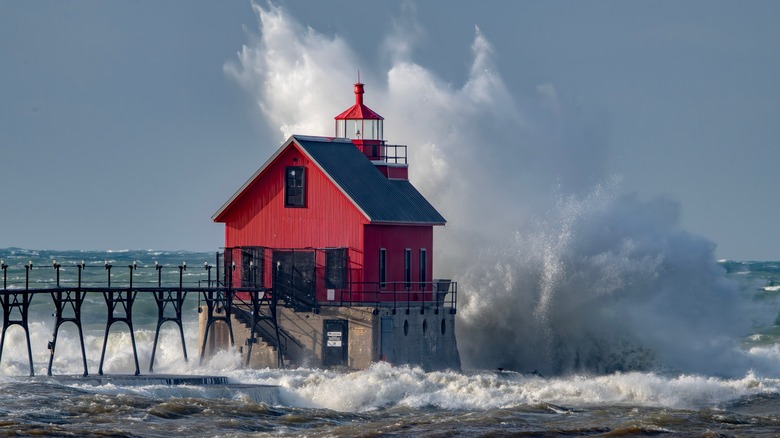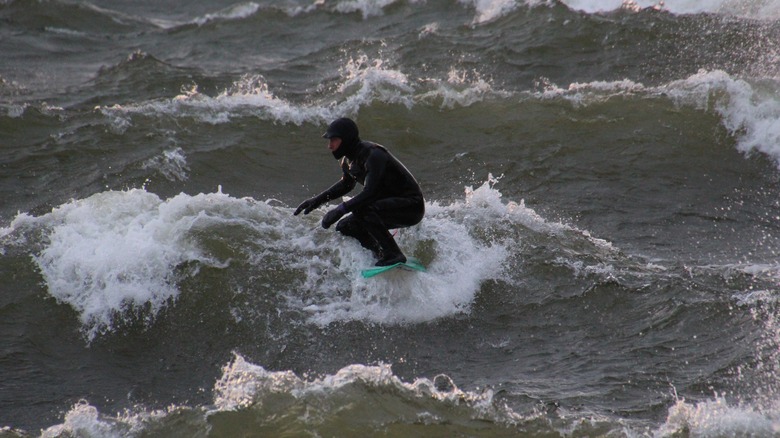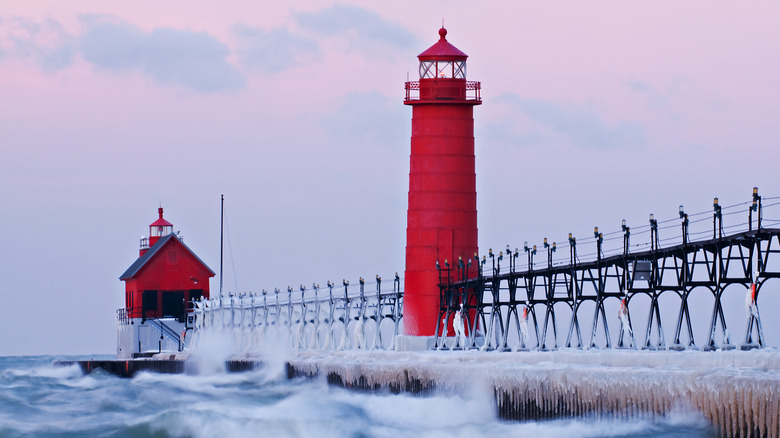It May Be Best To Avoid This Beach Known As The Most Dangerous Shoreline On The Great Lakes
The United States has no shortage of natural wonders, and the Great Lakes — Michigan, Superior, Huron, Ontario, and Erie — are undoubtedly among them. Their size is staggering, covering over 94,000 square miles and collectively containing around a fifth of the planet's fresh water. The lakes are also a major tourist attraction, drawing people from all over the world. Lake Michigan, the only lake located completely within the United States, welcomes around 20 million visitors each year. The natural beauty of its shores is without question, and there are many beaches and resorts along its edge that cater to all comers. However, Lake Michigan has deadly beaches worth avoiding — one beautiful spot notorious for its hazardous conditions can be found at Grand Haven.
Located on the eastern side of Lake Michigan (around a 30-minute drive from downtown Grand Rapids), Grand Haven is a small, peaceful city of around 11,000 residents. Founded in 1835, the town is probably best known for its boardwalk, miles of white sandy beaches, and stunning lighthouse that looks best in the winter. Grand Haven is regularly ranked among the best destinations for beaches in the United States and a great place for family road trips, but there is a darker side to all the holiday fun it offers. Since 2018, six people have lost their lives in its waters.
What makes Lake Michigan so dangerous?
You need to be extra alert when swimming in Lake Michigan because it has a reputation as the roughest of the Great Lakes. In 2023, it was reported that just under half of all 85 drownings that tragically occurred in the Great Lakes took place in Lake Michigan, and a further 40 people lost their lives there in 2024. There are numerous factors that contribute to this, which are sometimes hard to get your head around if you've never visited a lake of this magnitude before. Due to its sheer size, Lake Michigan behaves much like the ocean, with sudden storms, powerful high waves, underwater hazards, and deadly rip currents. To make matters worse, the state of Michigan was forced to cut back all its lifeguard services in 1993, leaving the Great Lake's beaches unsupervised.
Grand Haven, for all its undoubted beauty and charm, is just as susceptible to these dangers. Indeed, the beach was hit by a meteotsunami (a tsunami caused by storm conditions rather than tectonic activity) on July 4, 1929. Around 45,000 people were enjoying their day out when waves up to 20 feet tall crashed on the shore, killing 10 people. More recently in August 2022, a 21-year-old man was swept away and drowned during single red-flag conditions off Grand Haven — a second red flag would have closed the swimming area for safety precautions.
How to stay safe and enjoy Grand Haven's beaches
The good news is that the Grand Haven authorities have recently upgraded the safety features on the city's beaches to help prevent dangerous and fatal incidents in the water. In May 2024, it was announced that 12 new solar-powered safety towers designed by tech company SwimSmart had been installed, each with a range of features. The eight red towers are Wi-Fi enabled, enabling them to pick up the latest real-time weather conditions on the lake and act like a stop light, indicating how safe it is to swim. Other features include loudspeakers, video monitoring, and flotation equipment to help keep visitors informed and safe. The four blue towers also have public address systems and phones available so beachgoers can contact rescue services in an emergency.
Beyond paying attention to Grand Haven's new safety features, you should take into serious consideration whether you swim off the city's beaches or anywhere else along the shores of Lake Michigan. With no lifeguard services currently in play, you'll be on your own if you run into trouble. If you do decide to take a dip, however, there are ways that you can limit the danger. Don't swim within 24 hours of rain or 48 hours of particularly heavy downpours. Check the Surf Zone Forecast, which includes details on weather conditions and rip current risks. Regarding the latter, learn the signs that might indicate whether a deadly current is present before entering the water.


